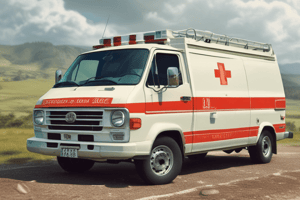Podcast
Questions and Answers
What is the primary purpose of first aid?
What is the primary purpose of first aid?
- To provide medical treatment
- To diagnose medical conditions
- To preserve life, prevent further harm, and promote recovery
- To call for medical help (correct)
What should you do first at the scene of an emergency?
What should you do first at the scene of an emergency?
- Check the person's airway, breathing, and circulation
- Check the scene for safety (correct)
- Provide basic care for bleeding
- Call for medical help
How should you apply direct pressure to a wound?
How should you apply direct pressure to a wound?
- Using a pressure point
- Using a clean cloth or bandage (correct)
- Using a tourniquet
- Using a dirty cloth
What is the correct rate of chest compressions during CPR?
What is the correct rate of chest compressions during CPR?
What should you do to relieve choking?
What should you do to relieve choking?
What should you do to treat shock?
What should you do to treat shock?
What should you do if someone has a diabetic emergency?
What should you do if someone has a diabetic emergency?
What should you do if someone has a poisoning emergency?
What should you do if someone has a poisoning emergency?
Flashcards are hidden until you start studying
Study Notes
General Principles
- First aid is the immediate care given to a person who has been injured or suddenly taken ill.
- The purpose of first aid is to preserve life, prevent further harm, and promote recovery.
Priorities
- Check the scene for safety
- Check the person's airway, breathing, and circulation (ABC)
- Call for medical help if necessary
- Provide basic care for bleeding, shock, and other injuries
Bleeding and Wound Care
- Apply direct pressure to the wound using a clean cloth or bandage
- Elevate the injured limb above heart level
- Apply a tourniquet or pressure point only if trained to do so
- Use gloves and other personal protective equipment (PPE) to prevent bloodborne pathogen transmission
Cardiac Emergencies
- Cardiopulmonary resuscitation (CPR):
- Chest compressions: 30 compressions per minute
- Rescue breaths: 2 breaths per minute
- Automated external defibrillator (AED) use:
- Follow device instructions
- Use on unconscious person with no breathing or pulse
Respiratory Emergencies
- Choking relief:
- Back blows: 5 blows between the shoulder blades
- Abdominal thrusts: 5 thrusts
- Asthma and anaphylaxis:
- Use inhaler or epinephrine auto-injector as directed
- Call for medical help
Shock and Burn Care
- Shock:
- Lay person down with legs elevated
- Loosen tight clothing
- Keep person calm and quiet
- Burns:
- Cool with cool water (not ice or ice water)
- Remove jewelry and tight clothing
- Cover with a sterile, non-stick dressing
Medical Conditions
- Diabetes:
- Recognize signs of hypoglycemia (low blood sugar)
- Administer glucose or sugar as directed
- Epilepsy:
- Clear the area around the person
- Loosen tight clothing
- Turn person on their side in recovery position
Other Emergencies
- Poisoning:
- Call the poison control center
- Identify the poison if possible
- Follow instructions from the poison control center
- Allergic reactions:
- Administer epinephrine as directed
- Call for medical help
General Principles
- First aid is the immediate care given to a person who has been injured or suddenly taken ill.
- The purpose of first aid is to preserve life, prevent further harm, and promote recovery.
Priorities
- Check the scene for safety before approaching the person.
- Check the person's airway, breathing, and circulation (ABC) to ensure they are breathing and have a pulse.
- Call for medical help if necessary, especially if the person is unresponsive or has severe injuries.
- Provide basic care for bleeding, shock, and other injuries.
Bleeding and Wound Care
- Apply direct pressure to the wound using a clean cloth or bandage to stop bleeding.
- Elevate the injured limb above heart level to reduce bleeding.
- Apply a tourniquet or pressure point only if trained to do so, as it can cause harm if not used correctly.
- Use gloves and other personal protective equipment (PPE) to prevent bloodborne pathogen transmission.
Cardiac Emergencies
- Perform cardiopulmonary resuscitation (CPR) on a person who is unresponsive, not breathing, or has no pulse.
- CPR involves 30 chest compressions per minute and 2 rescue breaths per minute.
- Use an automated external defibrillator (AED) on an unconscious person with no breathing or pulse, following the device's instructions.
Respiratory Emergencies
- Relieve choking by giving 5 back blows between the shoulder blades, followed by 5 abdominal thrusts.
- Use an inhaler or epinephrine auto-injector as directed to treat asthma and anaphylaxis attacks.
- Call for medical help immediately after relieving the attack.
Shock and Burn Care
- Treat shock by laying the person down with their legs elevated, loosening tight clothing, and keeping them calm and quiet.
- Treat burns by cooling them with cool water (not ice or ice water), removing jewelry and tight clothing, and covering with a sterile, non-stick dressing.
Medical Conditions
- Recognize signs of hypoglycemia (low blood sugar) in diabetic individuals, such as dizziness, sweating, and confusion.
- Administer glucose or sugar as directed to treat hypoglycemia.
- Treat epilepsy by clearing the area around the person, loosening tight clothing, and turning them on their side in the recovery position.
Other Emergencies
- Call the poison control center immediately in case of poisoning, and identify the poison if possible.
- Follow instructions from the poison control center to treat the poisoning.
- Treat allergic reactions by administering epinephrine as directed and calling for medical help.
Studying That Suits You
Use AI to generate personalized quizzes and flashcards to suit your learning preferences.




